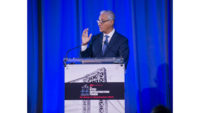Materials
New York City Accepts Use of SpeedCore High-Rise System
Milestone comes after tests showing the Lego-like composite core needs no fire protection

Seattle's Rainier Square Tower, shown under construction but now nearing completion, is the 850-ft-tall proof of concept for the SpeedCore system.
Photo courtesy Lease Crutcher Lewis
Supporters of a high-rise lateral-load resisting system of tied dual-plate wall modules field-filled with concrete—dubbed SpeedCore for its potential to slash superstructure construction time compared to steel frames with reinforced concrete cores—have reason to celebrate. The New York City Dept. of Buildings has granted permission to use the system in New York City.
The city's acceptance is the second piece of positive news for the American Institute of Steel Construction (AISC), which filed for the New York City approval, and for the Lego-like system’s mastermind, structural engineer Ron Klemencic, chairman and CEO of Magnusson Klemencic Associates (MKA). Recent fire tests showed the steel-plate walls do not need costly fire protection, known to slow construction.
Klemencic, ENR’s 2018 Award of Excellence winner for his research evangelism resulting in design and construction innovations, such as SpeedCore, calls the New York City approval “another step forward.”
New York City’s nod is likely to increase SpeedCore’s popularity, says Lawrence F. Kruth, AISC’s vice president of engineering and research.
Kruth, who had filed the alternate material application for SpeedCore about 18 months ago, received the news in an acceptance letter dated July 17 from the New York City Office of Technical Certification and Research. Among its other functions, OTCR evaluates new technology that enhances safety, sustainability and efficiency.
The approval is significant to AISC because it paves the way for the use of the system as a “lateral support wall system in the construction of high-rise buildings to resist wind load and seismic loads,” says the OTCR letter.
Material and Equipment Acceptance
The OTCR letter only addresses material/equipment acceptance. Project approval and permits must be obtained from the Dept. of Buildings through the required application process, in compliance with the New York City Construction Code.
Prior to approval, SpeedCore must comply with additional design, filing, permitting, installation and inspection requirements. The AISC Design Guide 32 “Design of Modular Steel-Plate Composite Walls for Safety-Related Nuclear Facilities” may be used as guidance on how to apply AISC 360 and AISC 341 specifications for the design of SpeedCore,” says OTCR, in its letter to Kruth.
For each SpeedCore project, the city is also requiring peer review for all structural design and calculations: “The reviewer must review and certify that all design, calculations, details, installation and inspection are in accordance with New York City Construction Code. The reviewer(s) shall be retained by the owner and shall be approved by the buildings department prior to commencing the review." The reports of peer reviews “shall be signed, sealed and filed as a required item prior to construction document approval,” states the acceptance letter.
In addition to the usual requirements for plan approval and permits, a SpeedCore project is subject to special inspection.
The letter states a warning: “In the event of noncompliance with any of the requirements listed above or unresolved system failure during operation, the SpeedCore will be required to be removed at the owner’s expense.”
Guide to Bolted Version of SpeedCore Coming
Researchers are working on design guidance for a field-bolted version of SpeedCore, which may be faster to erect in cold climates where preheating of welds is often necessary. Research on the bolted version, sponsored by AISC, has been delayed some months due to the COVID-19 pandemic, says Kruth. He expects the design guide to be issued by the middle of next year, at the latest.
Rainier Square Tower, MKA’s 850-ft-tall proof of concept for SpeedCore, is nearing completion in Seattle. The Erection Co. Inc., led by its founder, CEO and 2019 ENR Newsmaker Adam Jones, erected the structure in only 10 months.
Excavation is underway for MKA's second SpeedCore project—a 20-story building named 200 Park Avenue in San Jose, Calif. Superstructure erection is due to start next March, says Klemencic. The general contractor is Level 10. Schuff Steel is the fabricator-erector. Wall module splices will be field-welded, as they were at Rainier Square Tower.
MKA is currently designing two schemes for a Boston project—one with a field-bolted version of SpeedCore and one with a structural concrete core. This fall, Turner Construction Co. will evaluate the schemes for cost, speed and risk. Klemencic declines to reveal any more details about the project.






